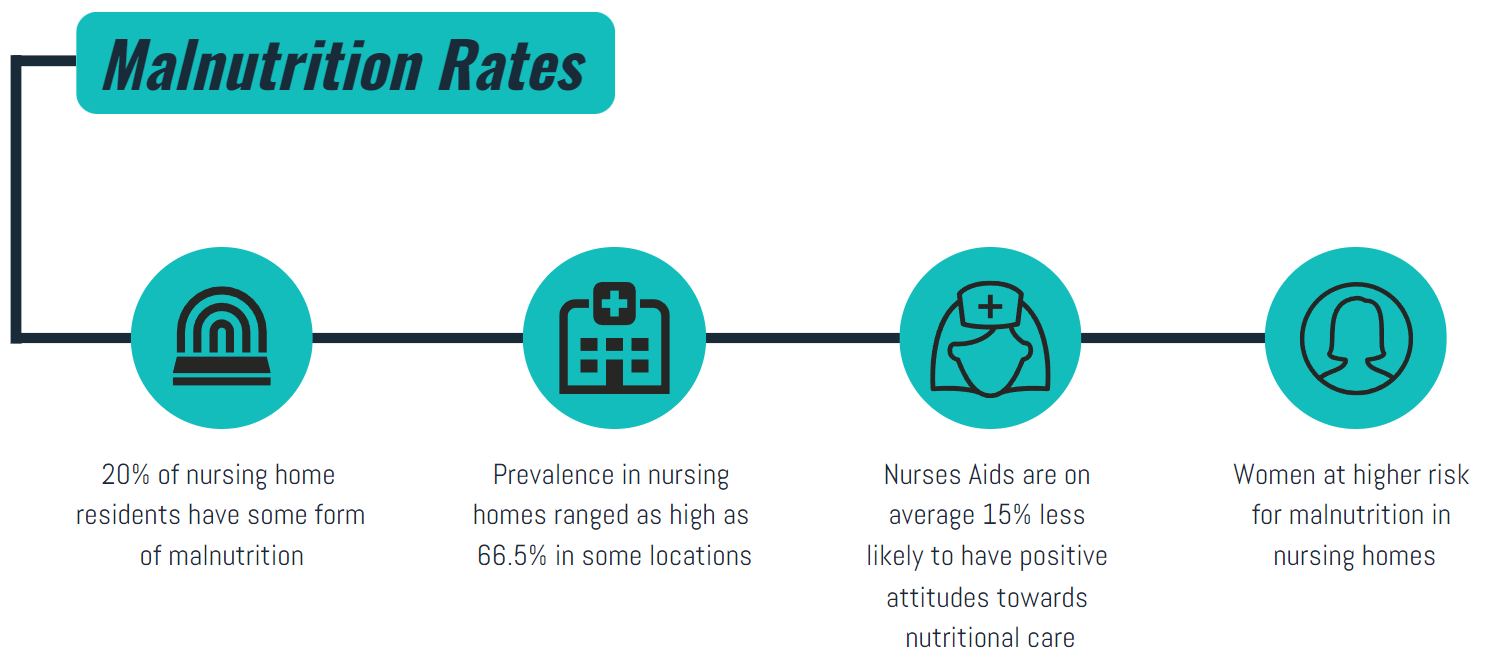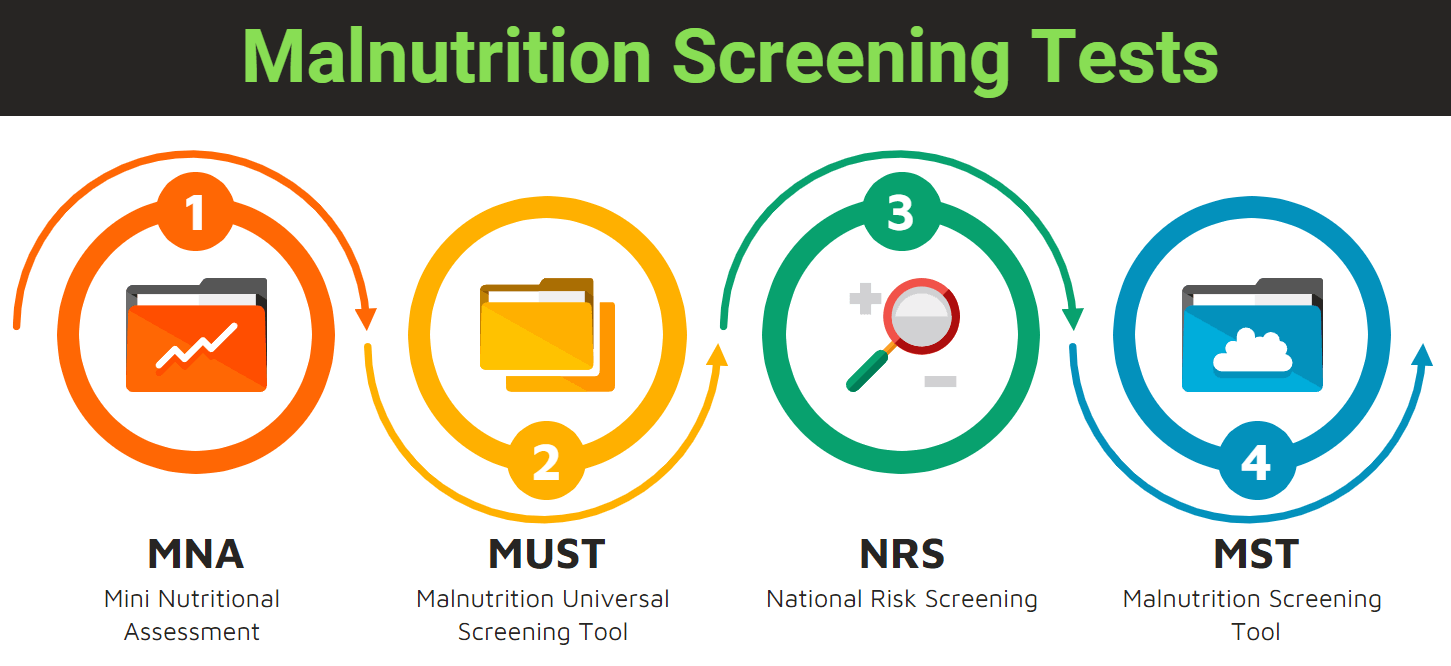Article Updated: April 22, 2022
Malnutrition in Nursing Homes
One after another, each expert witness I speak to on this issue repeats the same phrase: the labs don’t lie!
What does it mean? It means when a nursing home is basically starving its residents, not monitoring their food intake, not properly care planning for nutritional intake, the nursing home and their staff will always lie about it and deny their negligence.
But you know what they can’t lie their way around? The lab results, which leave behind a bread crumb of evidence to prove what a terrible place the nursing home was and is for your malnourished family member.
Below is my research on this topic. If your loved one suffered a serious physical injury resulting from nursing home neglect, I invite you to email or call me for a free consultation.
Clickable Table of Contents
Nursing Home Malnutrition 411
1 – Malnutrition In Nursing Homes Occurs Frequently
2 – Preventing Malnutrition In Nursing Homes
3 – Malnutrition & Dehydration In Nursing Homes Go Hand In Hand
4 – Malnutrition In Nursing Homes Q&A
5 – Get Help From An Experienced Nursing Home Malnutrition Lawyer
Resources
6 – Supporting Literature, Citations & Research
7 – About the Author
8 – Legal Help in Maryland & Nationally
Malnutrition In Nursing Homes Occurs Frequently
Preventing malnutrition in nursing homes should be a simple task but many nursing homes fail to ensure even this basic protection of the well-being of their residents.
When a person in a nursing home is at risk of being dehydrated, they are also at high risk of being malnourished as well.
The combination of lacking hydration and lack of proper nourishment led to nearly 1,500 deaths between 1999 and 2002 alone.
The problem has only gotten worse since then as nursing homes have become more congested and the population of elderly in the country have increased exponentially.
A number of health conditions and physical limitations add to the higher rates of malnutrition in the elderly population including difficulty swallowing and taking medications that reduce appetite.
What Is The Prevalence Of Malnutrition In Nursing Homes
Those who live in nursing homes have on average a 20% rate of malnutrition but in some cases these numbers go as high as 66%.
There are federal and state laws that protect the nutritional needs of those in nursing homes but a large number of nursing homes are not able to provide this basic level of care.

A study in 2000 even found that some nursing homes had an 85% rate of nutrition problems amongst its residents.
This in some ways mirrors the prevalence of malnutrition of older adults who do not live in nursing homes, which has been found to be as high as 50% of the population.
The rates are high in nursing home residents too, but generally much higher despite there being nurses to help ensure the problem is not serious in nursing homes.
Malnutrition And Dehydration In Nursing Homes: Why Is This So Prevalent?
The reasons for this problem being so high, with some nursing homes averaging rates as high as 66.5% of the residents being malnourished, is that many physical health, mental health and cognitive problems are present for this older population.
Some of the most common reasons that malnutrition takes place includes:
◊ Depression
◊ Swallowing difficulties
◊ Emotional difficulties
◊ Lack of interest in food or eating
◊ Cognitive impairment
The biggest effect of malnutrition amongst those who are in nursing homes is death which highlights how serious this problem really is.
Preventing Malnutrition In Nursing Homes
There are interventions that can help address malnutrition in nursing home staff.
Preventing malnutrition in nursing homes can be accomplished as there are many tools to prevent and deal with nutritional problems.
Assessing risk for malnutrition in nursing homes is the first step that needs to be taken in order to address this health problem. With proper assessment, solutions can be introduced early on before the nutrition issues become too severe.
One solution is the addition of dietary supplements for those who are showing weight loss and poor markers on nutritional assessments of their health.
Offering greater food choices and helping to ensure that staff are trained in dietary knowledge are other ways that malnutrition in nursing homes can be addressed effectively.
Malnutrition in Nursing Homes Risk Factors
Preventing malnutrition in nursing homes also comes down to understanding the risks for this problem in a care facility.
One study of over 1100 residents in a nursing home found that 38.7% were at risk for malnutrition and 19.4% were malnourished and that in this same population, many risk factors could help identify the prevalence of malnutrition in nursing homes.
◊ The warning signs included:
◊ Presence of a wound/pressure ulcer
◊ A recent hospitalization (<3 months ago)
◊ Suffering from a lower cognitive state
◊ Being involved in a tailored nutritional intervention
Malnutrition and dehydration in nursing homes are a serious problem, but there are many warning signs that should be able to alert nursing home staff that there is a condition that needs to be taken care of.
Assessing risk For Malnutrition In Nursing Homes

To do this they can use one of the many screening tests that exist for catching malnutrition.
These tests include the:
◊ Mini Nutritional Assessment (MNA)
◊ Malnutrition Universal Screening Tool (MUST)
◊ Nutritional Risk Screening 2002 (NRS)
Each of these tests were created to help nursing home staff identify the potential for an individual to become malnourished.
The tests check for BMI, age, gender, dietary intake needs, the presence of underlying illnesses, as well as a number of other markers to help focus in on those who are at higher risk for nutritional problems with their diets.
These tools should help nursing home staff identify who needs to be monitored more closely so that they can actively help them avoid malnutrition versus retroactively help them recover from malnutrition.
Malnutrition And Dehydration In Nursing Homes Go Hand In Hand
One way that nursing home staff can help identify early cases of malnutrition is to keep an eye on those who have problems with hydration.
Some factors are present in both of these populations and include issues such as immobility, poor oral intake, chewing problems, dysphagia, female gender, and older age.
Other factors that impact both hydration and nutrition in nursing home staff included the presence of dementia and other illnesses that caused an individual to forget to eat as frequently as they should, or medications that lowered their appetite to the point that they neglected to eat at all.
Prevalence Of Malnutrition In Nursing Homes: Nurses Role?
Both hydration and nutrition in nursing home residents can be impacted greatly by the nurses and caregivers in the care home.
Nurses tend to know more about nutritional importance than nurses aids, which can be a problem when the nurses aid is the most frequent point of contact with the residents of the nursing home.
Studies have found that registered nurses knew significantly more than nurse aides in relation to malnourishment and dietary needs of nursing home residents.
Additionally, nurses aids were far less likely to have a positive attitude towards nutritional care as well as knowing who the stakeholders were in nutritional treatment overall.
Nurses have a large responsibility to address the needs of residents in nursing homes who rely on them. In order to meet these needs, nurses need to conduct assessments and screenings as well as administer interventions as needed.
Malnutrition is something that nurses deal with on an almost daily basis because it is so common in older populations that they help. Nurses are so important that they are often the single individual standing between a death that can come due to malnutrition and proper care that can prevent malnutrition outright.
A Nursing Home Malnutrition Lawyer Can Help You
Nutrition is the responsibility of the individuals who are in charge of a nursing home. No matter the problems that lead to malnutrition, the nurses, nurses aids and other professionals are responsible for making sure that an elderly individual is eating and has the proper nutrition.
There is no situation in which it is permissible that you or a loved one should be left in a malnourished state without proper attention, care and treatment to help remain healthy.
Very frequently, the outcome of malnutrition is death and in these cases an attorney can help you get the compensation that you deserve.
It is important to remember that it is not normal to suffer through malnutrition and that neither older age nor the presence of an illness means it is ok to ignore poor nutrition or weight loss.
In cases like this you have a right to seek out damages from those who neglected your care or the care of someone you love.
Malnutrition In Nursing Homes Q&A
Is preventing malnutrition in nursing homes the job of the nurses and nurses aids?
Preventing malnutrition in nursing homes is the job of whoever the primary caregiver is in the care home. This happens to very often be the nurses and nurses aids who have the most contact with the residents in nursing homes. Because of this, nurses are often responsible for making sure that residents are not malnourished.
What is the prevalence of malnutrition in nursing homes?
Malnutrition in nursing homes is a common problem and happens at rates as high as 50% to 85% of those in care homes. The older population in general tends to have a higher risk of malnutrition, but those in nursing homes have even higher than average rates because they are dependent on others for their food and also exhibit many health problems that can lead to malnourishment.
Someone died due to malnourishment, do I need a nursing home malnutrition lawyer?
Yes, if someone you know died in a nursing home due to malnourishment you will need to contact a lawyer to help make sure you receive the compensation that you and your family are entitled to. Nursing homes will work hard to deny accountability and make it seem that they had no control over the malnutrition of a resident and a lawyer will be your best bet to be successful in a court case.
Are there ways to assess risk for malnutrition in nursing homes?
There are many tests that can help assess whether a person is malnourished or if they are at risk of malnourishment. These tests can be given to nursing home resident at any time to help understand their risk of having nutrition problems and also to create plans of actions to reverse malnourishment in a nursing home resident.
Can malnutrition in nursing homes be prevented?
Yes, malnutrition in a nursing home can be prevented through the use of assessment tools to help identify risk of the problem as well as with the use of treatment plans, dietary supplements, increased food choices and many other potential solutions that are catered to the needs of the individual resident.
Get Help From An Experienced Nursing Home Malnutrition Lawyer
Malnutrition related injuries in nursing homes are common and could lead to serious injuries, including death.
There is no reason that you should deal with a situation on your own. The help of an experienced nursing home attorney with a history of helping people in your exact situation can assist you in this difficult time.
You can contact me with the form below or you can also email me for a free consultation at your convenience. I hope that you find answers, and justice, for what the nursing home is putting you and your family through.
Reza Davani, Esq.
State Bar No.: #1212110211
Federal Bar No.: #30168
Cellphone: (301) 922-4598
Email: reza@nursinghometruth.com

Supporting Literature, Citations & Resources:
Tamura, B. K., Bell, C. L., Masaki, K. H., & Amella, E. J. (2013). Factors associated with weight loss, low BMI, and malnutrition among nursing home patients: a systematic review of the literature. Journal of the American Medical Directors Association, 14(9), 649-655.
Bell, C. L., Lee, A. S., & Tamura, B. K. (2015). Malnutrition in the nursing home. Current Opinion in Clinical Nutrition & Metabolic Care, 18(1), 17-23.
Verbrugghe, M., Beeckman, D., Van Hecke, A., Vanderwee, K., Van Herck, K., Clays, E., … & Verhaeghe, S. (2013). Malnutrition and associated factors in nursing home residents: a cross-sectional, multi-centre study. Clinical nutrition, 32(3), 438-443.
Diekmann, R., Winning, K., Uter, W., Kaiser, M. J., Sieber, C. C., Volkert, D., & Bauer, J. M. (2013). Screening for malnutrition among nursing home residents—a comparative analysis of the mini nutritional assessment, the nutritional risk screening, and the malnutrition universal screening tool. The journal of nutrition, health & aging, 17(4), 326-331.
Bauer, S., Halfens, R. J., & Lohrmann, C. (2015). Knowledge and attitudes of nursing staff towards malnutrition care in nursing homes: a multicentre cross-sectional study. The journal of nutrition, health & aging, 19(7), 734-740.
About the Author
This nursing home and medical malpractice article was written by Baltimore, Maryland nursing home attorney Reza Davani, Esquire. Mr. Davani received his Juris Doctor degree from a Tier 1 law school, the University of Maryland Francs King Carey School of Law. He received his first license to practice law from the State of Maryland’s Court of Appeals (MD State License No. 1212110211), and just four months later received a federal law license from the United States District Court for the District of Maryland (Federal License No. 30168).
Mr. Davani has been practicing law for over 10 years. He began practicing law by helping clients as a sanctioned student lawyer before receiving his law license, and second chaired his first jury trial in federal court before even graduating law school. He is a registered member of the Maryland Association for Justice (MAJ), the American Bar Association (ABA), the American Association for Justice (AAJ), and was formerly on the MAJ’s Legislative Leader’s Circle.
Mr. Davani has taken over 20 cases to trial in state and federal court, and favorably settled well over 100 cases for injured victims. He has personally helped his clients recover over $15,000,000 in personal injury, medical malpractice, and nursing home abuse settlements and verdicts in Maryland and other states. He is dedicated to fighting for justice, and welcomes the opportunity to help you.
Nursing Home Abuse Lawyer Near You in
Baltimore, Maryland, Helping Clients Nationally
I can help you anywhere in Maryland, including Allegany County, Anne Arundel County, Baltimore City, Baltimore County, Carroll County, Calvert County, Caroline County, Cecil County, Charles County, Dorchester County, Frederick County, Garrett County, Harford County, Howard County, Kent County, Montgomery County, Prince George’s County, Queen Anne’s County, Somerset County, St. Mary’s County, Talbot County, Washington County, Wicomico County, and Worcester County.
I have helped clients in over a dozen jurisdictions, including California, Delaware, District of Columbia, Georgia, Illinois, Iowa, Massachusetts, Maryland, Mississippi, New Jersey, New Mexico, New York, North Carolina, Pennsylvania, South Carolina, Washington, and Virginia.
I help injured victims nationwide in all 50 states on a case-by-case basis via Pro Hac Vice.



